In Hysopt there are 5 boiler types of which three use natural gas as fuel and two uses electricity as energy source. Before we dive in the different type of boilers, we give some context on the calorific value of natural gas used in Hysopt.
Calorific value (Natural gas)
Hysopt calculates by default with the Gross Calorific Value (GCV) of natural gas, also called the High Heating Value (HHV). The default efficiency table of the boilers will never exceed 100%. In the Pareto Analysis, the corresponding gas price and emission factor must be provided per kWh of HHV natural gas.
Hysopt calculates by default with the Gross Calorific Value (GCV) of natural gas, also called the High Heating Value (HHV). The default efficiency table of the boilers will never exceed 100%.
If you prefer to work with the Net Calorific Value (NCV), also called the Lower Heating Value (LHV), you can update the efficiency table manually of the gas boilers to LHV efficiencies using Changing boiler efficiency (with templates). These efficiency values can exceed 100%. In the Pareto analysis, you must correspondingly use the gas price and emision factor per kWH of LHV gas.
1. Boiler with setpoint (simplified boiler)
The simplified boiler model generates the temperature that is given as a setpoint. The setpoint can vary depending on the chosen control Base Circuit (BC), and it is connected to the upper left corner of the boiler BC. More information on the setpoints can be found in Generator.
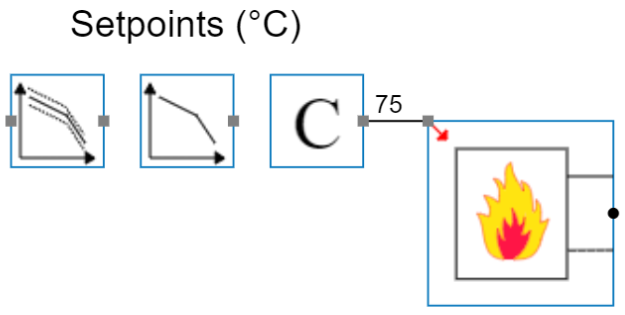
If you want to specify the pressure loss of the boiler (or the KV value), you can do so by adjusting the Pressure Drop in Design parameter. This value will impact the pump head calculation.

The boiler output capacity is automatically filled in after doing the "Optimise System Components" based on the secondary side design heat flow. Note that the boiler output capacity will not have any influence in simulation, as the boiler is assumed to be ideal and will always deliver the requested setpoint temperature. As a consequence, the boiler is able to deliver heat flows higher than the maximal boiler capacity. If you want to ensure that the maximal capacity is taken into account during simulation, please use the dynamic controller boiler or the heat flow controlled boiler.

For more in-depth specification of the boiler, you can adjust the efficiency of the ideal boiler using the following parameters:

The nominal temperature difference is needed to set scale the efficiency lookup table and is default 20°C. The efficiency lookup table is used during simulation to accurately simulate the primary power and efficiency of the boiler both in full and partial load.
The user can insert and change the efficiency lookup table by clicking on the "pencil" icon. The popup-window has two modes: “Default” and “Custom”. In “Default”-mode, the default efficiency lookup table is used. The user can download the CSV file by clicking on the link indicated in blue. In “Custom”-mode, the user can choose to insert their own efficiency lookup table.
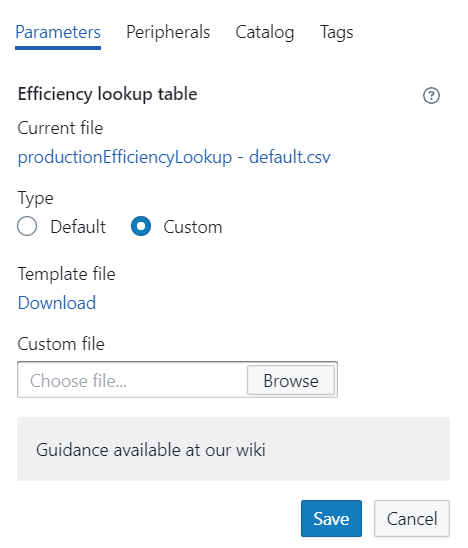
To do this, it’s advised to follow the following steps:
-
Download the template file by clicking on the blue link. This will give the user an indication of how the custom file must look like in order to be compatible with the Hysopt Optimiser.
-
The data needed to update the efficiency table is "relative mass flow", "relative power", "return temperature" and "efficiency". Depending on the three-dimensional matrix (relative mass flow, relative power, and return temperature) the efficiency of the boiler can vary. If the manufacturer-specific information is known, the user can enter this into the efficiency table to accurately simulate the boiler. If not, it’s advised to continue using the default efficiency table, as it's sufficiently accurate to represent a common gas condensing boiler model. In general, as long as you are working with a gas condensing boiler, working with the standard table is a good way to save on time.
-
Save the CSV file and close it. Go back to the Hysopt Optimiser and click on the “Browse” button in order to upload the custom efficiency lookup table. If everything is done right, the Optimiser will show a green prompt. If something went wrong, the Optimiser will show a red prompt with an indication where the error occured.
Always press the “Save” button before closing the pop-window. If you click on another component before saving, your upload will be cancelled!
A step-by-step guide on changing the efficiency lookup table, as well as exemplary templates, can be found here: Changing boiler efficiency (with templates)

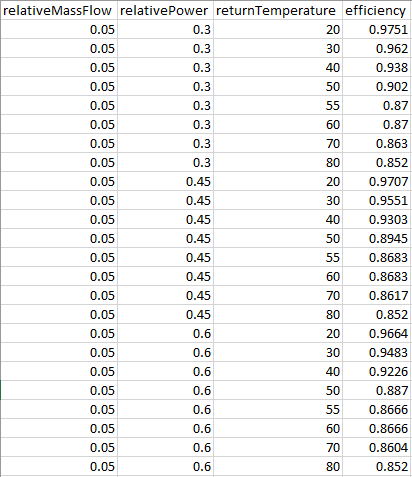
2. Dynamic controlled boiler
The dynamic boiler model is a more detailed boiler model than the "boiler with setpoint". Besides the efficiency lookup table, this BC has its own control loop, which controls a gas valve in function of the measured supply temperature. Therefore there are more parameters necessary than the "boiler with setpoint".

Besides the above-mentioned parameters, the user can also adjust the boiler capacitance. By default, the boiler capacitance is auto-scaled in a proportional manner in relation to the boiler output capacity.
If the boiler capacitance isn't known but the water content and mass of steel is known, the user can calculate the capacitance by clicking on the "pencil" icon and enter these aspects into the capacitance calculator. The average flow temperature and type of refrigerant can also be changed. Next, click on the “Calculate”-button in order to calculate the capacitance. The user can also rely on the auto-scale of the boiler capacitance which will provide a suitable water content for simulation based on the boiler power.
Always press the “Save” button before closing the pop-window. If you click on another component before saving, your calculation will be cancelled!
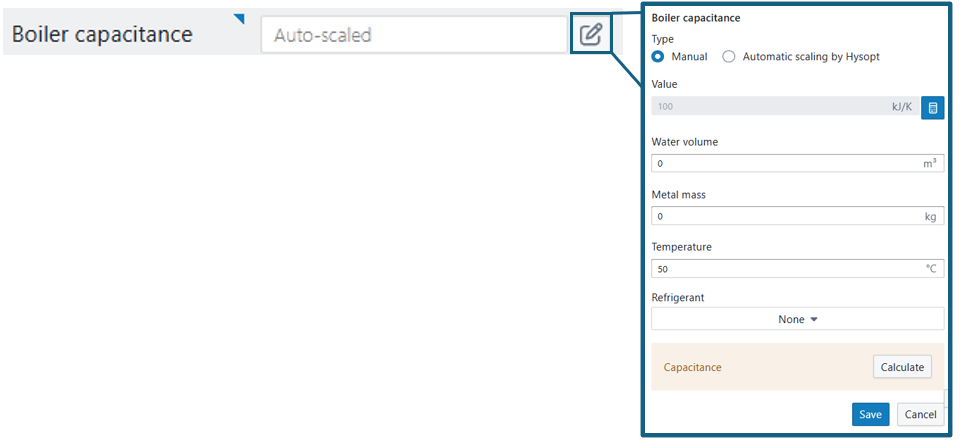
The minimal power percentage can be changed depending on the type of boiler. It defines the minimal modulation signal that must be given before the boiler activates. The percentage is taken from the “Maximal power” parameter.

Boilers also typically have thermal losses to the environment, which can be included by entering a certain UA-value. This UA value (W/K) represents the thermal power (W) lost depending on the temperature difference (K) of the boiler and the environment. Note that the environment temperature can also be changed by the user. In default, however, the thermal loss to the environment is indirectly included in the efficiency table, and the UA value is set to zero.


Furthermore, different control parameters are needed like the proportional band, repeat time, integral thresholds, etc. for accurate and stable control of the boiler. The default values and the control strategy are set resulting out of thorough communications with boiler manufacturers. If the user desires to change these, it's recommended to first contact one of our consultants.
For more information these control parameters, the user can have a look at the following section: Controller .

3. Heat flow controlled boiler
The heat flow controlled boiler is similar to the dynamic model with the only exception that this model has no internal control loop. The user has to apply a control loop on the boiler model, with as input on this model is a power modulation signal between 0 and 1.This model is primarily used for making a cascade control between several boilers or for educational purposes. All necessary parameters for this boiler model are mentioned above.
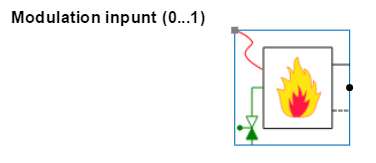
4. Electric boiler with setpoint
The electric boiler with setpoint is the same as the "boiler with setpoint" with the only exception that the default efficiency table is different. The efficiency of an electric boiler is typically 99%, so the efficiency table is just filled with one row resulting in a constant efficiency, independent of the modulation, return temperature, and flow rate.
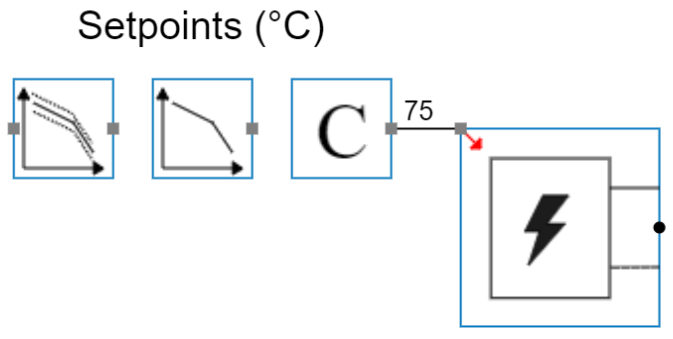
5. Dynamic electric boiler
The dynamic electrc boiler is similar to the heat flow controlled gas boiler but using electricity as primary fuel instead of natural gas. The efficiency of the electric boiler is a single value, which represents the conversion efficiency from electricity to heat. Losses to the enviroment can be specified separately with the thermal losses UA-value, or can be integrated in the efficiency value while putting the thermal losses UA-value to zero.
The boiler output capacity represents the maximal heat flow the boiler can provide continuously.
The control nodes (both inputs) are
-
Control signal: A value between 0-1 that represents the modulation of the electric boiler. A connection to this node is mandatory.
-
Activation signal: A boolean value that represents the release of the dynamic electric boiler. This connection is optional and will be interpreted as one if not connected.
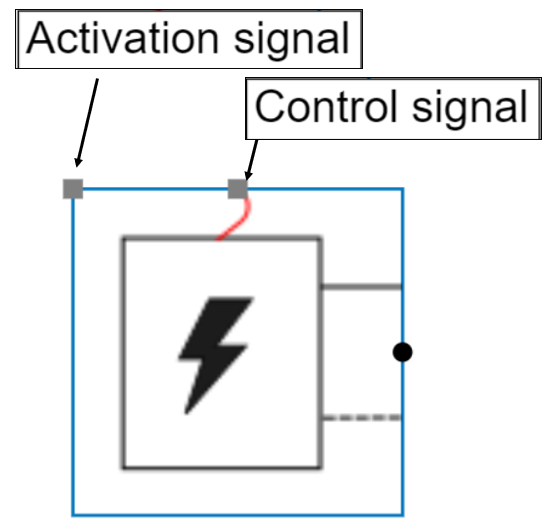
Examples of boiler concepts can be found in our Hysopt Inspiration Library: Boiler.
